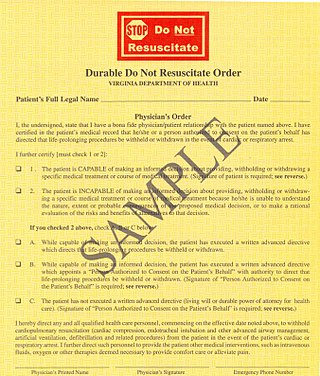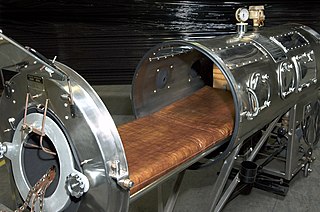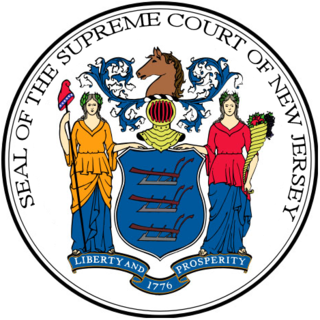Related Research Articles

Karen Ann Quinlan was an American woman who became an important figure in the history of the right to die controversy in the United States.

A do-not-resuscitate order (DNR), also known as Do Not Attempt Resuscitation (DNAR), Do Not Attempt Cardiopulmonary Resuscitation (DNACPR), no code or allow natural death, is a medical order, written or oral depending on the jurisdiction, indicating that a person should not receive cardiopulmonary resuscitation (CPR) if that person's heart stops beating. Sometimes these decisions and the relevant documents also encompass decisions around other critical or life-prolonging medical interventions. The legal status and processes surrounding DNR orders vary in different polities. Most commonly, the order is placed by a physician based on a combination of medical judgement and patient involvement.
Medical ethics is an applied branch of ethics which analyzes the practice of clinical medicine and related scientific research. Medical ethics is based on a set of values that professionals can refer to in the case of any confusion or conflict. These values include the respect for autonomy, non-maleficence, beneficence, and justice. Such tenets may allow doctors, care providers, and families to create a treatment plan and work towards the same common goal. It is important to note that these four values are not ranked in order of importance or relevance and that they all encompass values pertaining to medical ethics. However, a conflict may arise leading to the need for hierarchy in an ethical system, such that some moral elements overrule others with the purpose of applying the best moral judgement to a difficult medical situation. Medical ethics is particularly relevant in decisions regarding involuntary treatment and involuntary commitment.

Life support comprises the treatments and techniques performed in an emergency in order to support life after the failure of one or more vital organs. Healthcare providers and emergency medical technicians are generally certified to perform basic and advanced life support procedures; however, basic life support is sometimes provided at the scene of an emergency by family members or bystanders before emergency services arrive. In the case of cardiac injuries, cardiopulmonary resuscitation is initiated by bystanders or family members 25% of the time. Basic life support techniques, such as performing CPR on a victim of cardiac arrest, can double or even triple that patient's chance of survival. Other types of basic life support include relief from choking, staunching of bleeding by direct compression and elevation above the heart, first aid, and the use of an automated external defibrillator.

Mechanical ventilation or assisted ventilation is the medical term for using a machine called a ventilator to fully or partially provide artificial ventilation. Mechanical ventilation helps move air into and out of the lungs, with the main goal of helping the delivery of oxygen and removal of carbon dioxide. Mechanical ventilation is used for many reasons, including to protect the airway due to mechanical or neurologic cause, to ensure adequate oxygenation, or to remove excess carbon dioxide from the lungs. Various healthcare providers are involved with the use of mechanical ventilation and people who require ventilators are typically monitored in an intensive care unit.

An iron lung is a type of negative pressure ventilator (NPV), a mechanical respirator which encloses most of a person's body, and varies the air pressure in the enclosed space, to stimulate breathing. It assists breathing when muscle control is lost, or the work of breathing exceeds the person's ability. Need for this treatment may result from diseases including polio and botulism and certain poisons.
The right to die is a concept based on the opinion that human beings are entitled to end their life or undergo voluntary euthanasia. Possession of this right is often understood that a person with a terminal illness, incurable pain, or without the will to continue living, should be allowed to end their own life, use assisted suicide, or to decline life-prolonging treatment. The question of who, if anyone, may be empowered to make this decision is often the subject of debate.
Stephanie Keene, better known by the pseudonym Baby K, was an anencephalic baby who became the center of a major American court case and a debate among bioethicists.

Gillick competence is a term originating in England and Wales and is used in medical law to decide whether a child is able to consent to their own medical treatment, without the need for parental permission or knowledge.
Elizabeth Bouvia is a figure in the American right-to-die movement. Her case attracted nationwide attention in this area as well as in medical ethics.
Eluana Englaro was an Italian woman from Lecco, who entered a persistent vegetative state on 18 January 1992, following a car accident, and subsequently became the focus of a court battle between supporters and opponents of euthanasia. Shortly after her accident, medical staff began feeding Englaro with a feeding tube, but her father "fought to have her feeding tube removed, saying it would be a dignified end to his daughter's life. He said that before the crash his daughter visited a friend who was in a coma and told him she didn't want the same thing to happen to her if she were ever in the same state." The authorities refused his request, but the decision was finally reversed in 2009, and she died after her nutrition was withheld after she had spent seventeen years in the persistent vegetative state.
The obligatory dangerousness criterion is a principle present in the mental health law of many developed countries. It mandates evidence of dangerousness to oneself or to others before involuntary treatment for mental illness. The term "dangerousness" refers to one's ability to hurt oneself or others physically or mentally within an imminent time frame, and the harm caused must have a long-term effect on the person(s).
Child euthanasia is a form of euthanasia that is applied to children who are gravely ill or have significant birth defects. In 2005, the Netherlands became the first country since the end of Nazi Germany to decriminalize euthanasia for infants with hopeless prognosis and intractable pain. Nine years later, Belgium amended its 2002 Euthanasia Act to extend the rights of euthanasia to minors. Like euthanasia, there is world-wide public controversy and ethical debate over the moral, philosophical and religious issues of child euthanasia.
Both Euthanasia and Assisted Suicide are illegal in the United Kingdom and could be prosecuted as murder or manslaughter.
Muslim views on abortion are shaped by Hadith, as well as by the opinions of legal and religious scholars and commentators. The Quran does not directly address intentional abortion, leaving greater discretion to the laws of individual countries. Although opinions among Islamic scholars differ over when a pregnancy can be terminated, there are no explicit prohibitions on a woman's ability to abort under Islamic law.

Euthanasia in Canada in its legal voluntary form is called Medical Assistance in Dying (MAiD) and it first became legal along with assisted suicide in June 2016 for those whose death was reasonably foreseeable. In March 2021, the law was further amended by Bill C-7 which to include those suffering from a grievous and irremediable condition whose death was not reasonably foreseeable. According to the Fourth Annual Report on MAID, there were 13,241 MAID deaths reported in Canada in 2022.

In re Quinlan was a landmark 1975 court case in the United States in which the parents of a woman who was kept alive by artificial means were allowed to order her removal from artificial ventilation.
A beating heart cadaver is a body that is pronounced dead in all medical and legal definitions, connected to a medical ventilator, and retains cardio-pulmonary functions. This keeps the organs of the body, including the heart, functioning and alive. As a result, the period of time in which the organs may be used for transplantation is extended. The heart contains pacemaker cells that will cause it to continue beating even when a patient is brain-dead. Other organs in the body do not have this capability and need the brain to be functioning to send signals to the organs to carry out their functions. A beating heart cadaver requires a ventilator to provide oxygen to its blood, but the heart will continue to beat on its own even in the absence of brain activity. This allows organs to be preserved for a longer period of time in the case of a transplant or donation. A small number of cases in recent years indicate that it can also be implemented for a brain-dead pregnant woman to reach the full term of her pregnancy. There is an advantage to beating heart cadaver organ donation because doctors are able to see the vitals of the organs and tell if they are stable and functioning before transplanting to an ailing patient. This is not possible in a donation from someone pronounced dead.
M.T. v J.T., 140 N.J. 77, 355 A.2d 204, 205, is a 1976 New Jersey Superior Court case which affirmed the validity of a marriage between a post-operative trans woman to a cissexual man, and in particular recognized the plaintiff changed legal sex, from male to female, when she phenotypic sex through surgery. This case is believed to be the first to address the right of transsexual people to marry.
Baby M was the pseudonym of an Australian girl named Allison who was born with severe birth defects, whose treatment and eventual death caused significant controversy and international discussion about the medical ethics of disabled newborns. Right to Life activists accused her parents and the hospital of murdering the infant, leading to a lengthy legal inquest.
References
- 1 2 3 4 5 6 "Ms B v An NHS Hospital Trust [2002] EWHC 429 (Fam) (22nd March, 2002)". www.bailii.org. Retrieved 21 June 2020.
- 1 2 3 4 5 6 Slowther, A. (1 August 2002). "The case of Ms B and the "right to die"". Journal of Medical Ethics. 28 (4): 243. doi: 10.1136/jme.28.4.243 . ISSN 0306-6800. PMC 1733619 . PMID 12161579.
- 1 2 3 4 5 6 7 8 Szawarski, Piotr (1 January 2013). "Classic Cases Revisited: Allowing to Die and the Case of Ms B". Journal of the Intensive Care Society. 14 (1): 20–23. doi: 10.1177/175114371301400106 . ISSN 1751-1437.
- 1 2 "Miss B dies peacefully after ventilator is switched off". HeraldScotland. Retrieved 21 June 2020.
- 1 2 correspondent, Clare Dyer Legal (13 May 2002). "Pretty's legal battle for dignity in death". The Guardian. ISSN 0261-3077 . Retrieved 22 June 2020.
- ↑ Szawarski, Piotr (January 2013). "Classic Cases Revisited: Allowing to Die and the Case of Ms B". Journal of the Intensive Care Society. 14 (1): 20–23. doi: 10.1177/175114371301400106 . ISSN 1751-1437.
- ↑ "Miss B dies peacefully after ventilator is switched off". HeraldScotland. Retrieved 22 June 2020.
- ↑ Singer, P. (1 August 2002). "Ms B and Diane Pretty: a commentary". Journal of Medical Ethics. 28 (4): 234–235. doi: 10.1136/jme.28.4.234 . ISSN 0306-6800. PMC 1733618 . PMID 12161575.